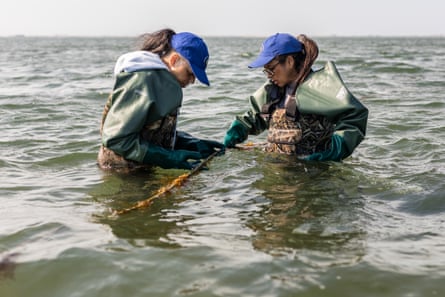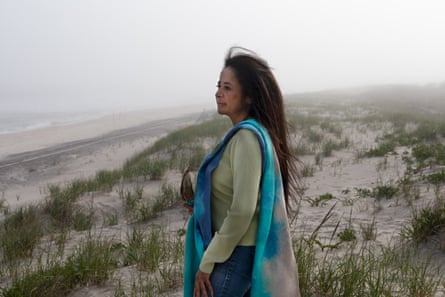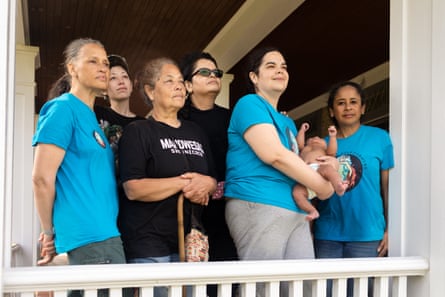Early on a January morning, a dozen nuns hopped on a Zoom call and waited patiently for their turn to speak softly, sweetly to plants.
One of the sisters sang a song; another played the flute; several recited poetry and prayers. The intended audience of their kind words were dozens of kelp seedlings, which had a big task: grow big and healthy enough to be planted in the waters off the shores of Long Island, New York.
The sisters are a part of a unique collaboration: situated on the edge of a bay, they have helped a group of women from the Shinnecock, a local Indigenous tribe, start a kelp farm in the hopes of cleaning up the pollution in their shared backyard.
“When we started our hatchery, we were doing a lot of research for ways to give our kelp the best start in life,” said tribal member Danielle Hopson Begun. “Studies have shown that plants respond well to high frequency tones.”
After the Zoom call, “I would tell you as someone who is in the hatchery every day, you could see the growth mushroom,” said sister Kerry Handal.
These two groups are united by proximity and purpose; both live on either sides of the Shinnecock Bay, and hope the growing and planting of kelp will help eliminate the carbon and nitrogen that had been poisoning their waters. The kelp seedlings also represent the latest efforts by an intergenerational group of Shinnecock women to combat the tribe’s disenfranchisement.
A maritime tribe, the Shinnecock Indian Nation have long depended on the bay to survive. In the last 40 years, overdevelopment in the Hamptons, without a municipal sewer system, coupled with fertilizer runoff, has elevated the nitrogen level in the bay.
In 2019, six Shinnecock women decided to take matters into their own hands. They formed a kelp farming collective, and enlisted the Sisters of St Joseph. Together they are working to rescue the bay on which both communities are situated: the sisters on a bucolic, sprawling 200-acre retreat center on the bay’s west side, and the Shinnecock on a 900-acre peninsula to the east.
It might seem like a long shot, except that it’s working.

“Our voices for so long have just been erased or silenced,” says Shinnecock tribal lawyer Tela Troge. “So it’s very – it’s refreshing. It’s empowering. To have […] anything that we individually or collectively need.”
Surrounded by the rich and famous
Drive by the multi-million-dollar homes, pools and golf courses of the renowned New York escape, Southampton, and you would scarcely know there is an Indigenous population there. But the Shinnecock have been on Long Island for the last 13,000 years, or as the Shinnecock will tell you, 400 generations.
They are one of New York’s oldest self-governing tribes, and about half of the tribal members live on the 900-acre peninsular reservation. Traditionally, the Shinnecock were a mariner tribe, and their history as expert fishermen, hunters, farmers, and whalers has proven critical in the absence of other economic opportunities. Today, however, the tribe faces constant ecological threats.
“It’s alarming. We’re looking at the very real situation or a possibility that we might have to relocate our entire tribal nation,” explains tribal attorney Troge. “We’re really disenfranchised by being in the place where we are so exposed to the elements. It’s really just like a thin barrier island that separates us from the Atlantic Ocean, so the ever-increasing intensity of super storms and hurricanes really threaten us.”

Fema estimates that by 2040, 100% of the Shinnecock territory will be underwater.
The more immediate threat is to the marine life that the nation has depended on to sustain them.
“For generations, we were taught how to live off the land, or how to fish for what we need, but it’s just not possible anymore because the nitrogen levels in the sea,” said Troge. “It’s killing all of the fish and the shellfish that have sustained us.”
In 2019, Toby Bloch, the director of infrastructure for GreenWave, a global nonprofit that provides training and support to regenerative ocean farmers, learned about the plight of the Shinnecock and believed he could help.
He reached out to long-time Shinnecock activist, Becky Genia to see if she had interest in starting a kelp farm. Research has found that sugar kelp can absorb carbon and nitrates from the water, making it a natural means of combating ocean acidification. Starting a kelp farm would involve developing kelp from seedlings in tanks in a hatchery and then farming them in the bay.

The Shinnecock have a long history of using seaweed for everything from currency to medicine, as well as beauty products and even insulation in homes – so to Genia, it felt like a natural pivot. But the tribe didn’t have a space for a hatchery, and they wanted to move quickly. They considered purchasing cargo containers before Genia realized the obvious answer to their dilemma was sitting right across the bay.
A helping hand
Tribal members had had meaningful contact with the sisters once before. In 2018, the remains of two Shinnecock children were finally returned to the tribe from the NYU Dental school, after years of campaigning by tribal members. Genia, Troge and the other tribal members hoped to rebury the remains as close as possible to their original burial site. Records showed that the location was a convent of the Catholic Sisters of St Joseph, a community with a property directly across from the reservation on the bay.
“We had never met them or we didn’t have a relationship with them, but they were so welcoming,” said Troge.
After consulting with the sisters, the tribe chose the monastery’s cemetery as the site for reburial. Several sisters joined the ceremony, and afterwards, the two groups shared a meal of corn, beans and squash and had friendship-forming conversations over shared values.

“It really amazed me that so many of the sisters joined us,” said Troge, “They were so respectful.”
When Genia contacted the monastery to discuss collaborating with the kelp farm, sister Joan was quickly on board.
“How can we deny them that?” she says, “The bay has their name!”
The sisters offered a cottage at their retreat center to serve as a hatchery. When the question of finances came up, sister Joan was clear: anything profits made from the kelp farm belonged to the Shinnecock. “We’re here to support you and to affirm you,” she said.
Within a couple of months, the cottage was transformed with fish tanks and warming lights. In 2021, the Shinnecock Kelp Farm was launched, and to date, 20 lines of kelp have been planted in the bay. The sisters help check the kelp lines or watching Troge’s one-year-old son when she visits. During the pandemic, they offered a “kind words program”, where sisters sang and recited poetry to the seedlings; now, they’re making it a regular practice.
Success
In the last two farming seasons, Troge has seen an increase in scallops, clams, sea horses, and other species she hasn’t seen in years, sheltering in their kelp lines. “We expanded our hatchery ten times this season,” said Hopson Begun. In addition to their original farming site, they have since added two more at opposite ends of the bay. They hope, in time, to expand their farm sites deeper into the bay and ocean, and are currently working to secure the boats they would need to do so.

While the water isn’t clean enough for human consumption, the farmers plan to explore other uses for the seaweed in the future like food and cosmetics, and are currently in product development to start selling it as fertilizer. They’ve been able to bring on four new Shinnecock crew members and look forward to creating more green jobs to support their tribal community. In March, the Shinnecock kelp farmers were awarded $75,000 to expand their kelp farm.
As a community in the throes of adversity, the outlook for future generations of tribal members may seem unpromised. But the Shinnecock are placing their trust in the same foundational values that have sustained them for 13,000 years.
“As Shinnecock we are taught to preserve our life for the next seven generations,” said Tela, “It’s what drives us to take action to protect the water now.”

